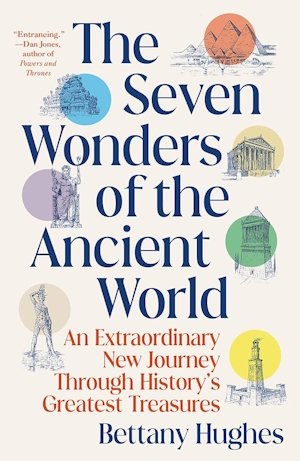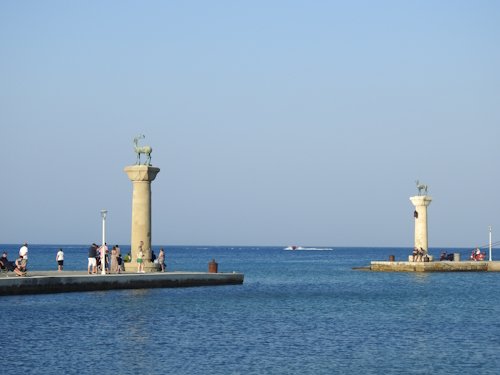Els Slots
Book: Seven Wonders
I recently have been reading ‘The Seven Wonders of the Ancient World’ by Bettany Hughes . It’s a very comprehensive account of the sites on this ancient Wonder-list and is based on up-to-date research. She sets out to discover "what the Seven Wonders meant to 'them' - to our relatives across time - and what they do and can mean to us" . The introduction chapter also details the ways of early ‘list-making’ – Hellenistic travellers were just as enthusiastic about groupings as we are today, frequently using lists of sevens (the most beautiful rivers, the highest mountains, etc.). An explanation she provides is that these groupings give cohesion to history.

The Wonders
I learned quite a bit from the book and also found further links to (T)WHS, so I could upgrade the existing connection . The Seven Wonders in chronological order, what’s left to see and their link to (T)WHS, were:
1. The Great Pyramid at Giza : the oldest Wonder but the only one still standing and the main component of a WHS. Only the Romans weren’t impressed!
The Wonder features prominently in the OUV statement for Memphis and its Necropolis in criterion i: “In Memphis was founded one of the most important monuments of the world, and the only surviving wonder of the ancient world, namely, the Great Pyramid of Giza” .
2. The Hanging Gardens of Babylon : the most enigmatic Wonder because it is unclear whether they ever existed, or whether they were located in Babylon or Nineveh. Some early Wonder lists named the ‘Walls of Babylon’ instead.
Its wondrous elements (Gardens, Tower) are part of the OUV of the WHS of Babylon , the (very short) TWHS description of Nineveh has no reference to it. We also had Museuminsel as part of the connection with its remains of the Ishtar Gate now in the Pergamon Museum, but I removed it to keep it more to the point (maybe we can create a new Connection with WHS connected to the Seven Wonders in the second grade).
3. The Temple of Artemis at Ephesus : this very large temple with a creative design at the time was a living cult site accessible to all, like the ones we now encounter in India. There's a link with the TWHS of Sardis , as this site provided the gold that funded the rebuilding of the temple in the 6th century BCE.
The Temple gets a short reference in the WHS of Ephesus OUV statement ( “Little remains of the famous Temple of Artemis, one of the ‘seven wonders of the world’ which drew pilgrims from all around the Mediterranean until it was eclipsed by Christian pilgrimage” )
4. The Statue of Zeus at Olympia : this huge golden statue, seated inside a temple, was visited by many, especially during the peaceful years when the Olympian Games were held. A single column of the temple is left standing, parts of the statue were later transported to Constantinople where they were displayed for some time near the Hippodrome.
The OUV of Olympia still heavily references it, even in criterion I ( “The sanctuary of the Altis contained one of the highest concentrations of masterpieces of the ancient Mediterranean world. Many have been lost, such as the Olympia Zeus, a gold-and-ivory cult statue which was probably destroyed by Pheidias between 438 and 430 BC and one of the seven wonders of the ancient world.” )
5. The Mausoleum of Halikarnassos : the mother of all Mausolea, named after the Karian king Mausolos. It was standing until 1400, when it was toppled by an earthquake. The ruins can still be visited in Bodrum, although most of the interest now lies underground.
The archaeological site of Halikarnassos has been on Turkey’s T List, but was removed in 1996. The current TWHS Bodrum Castle is also linked to this Wonder, as its spolia were used in building the Crusader Castle nearby and the proposed OUV partly relies on that fact.

6. The Colossus of Rhodes : this huge bronze statue of the sun god Helios only stood upright for about 60 years, before an earthquake destroyed it.
Although what has been inscribed as a WHS is the Medieval City of Rhodes , the OUV statement (criterion iv) still refers to the Colossus: “The fact that this medieval city .. commands a port formerly embellished by the Colossus erected by Chares of Lindos, one of the Seven Wonders of the ancient world, only adds to its interest.” However, the image of the giant straddling two sides of the harbour (photo above) is a medieval invention. It is now thought that the statue stood at the highest point of the City of Rhodes – maybe where the Grandmaster’s Castle now is or (more likely) at Monte Smith where the Helian Games were held. However, no traces have ever been found.
The Colossus also served as a source of inspiration for Bartholdi in designing the Statue of Liberty .
7. The Pharos Lighthouse at Alexandria: it survived until 1303 when it was felled by an earthquake as well. The foundations can still be seen and parts have been reused in the Fort.
Alexandria features on Egypt's T List as “ Alexandria, ancient remains and the new library ” and its description mentions “The lighthouse was one of the seven wonders of the world in antiquity. Its outline is known only from coins, a Byzantine mosaic discovered in Libya and the remains of a similar lighthouse in Taposiris Magna.”
Visiting them all
I added a new Community Ranking list of the members who have visited all 5 directly linked WHS and also 'ticked' the TWHS of Bodrum Castle and Alexandria - the closest remainders of the 2 non-WHS Wonders.
In Antiquity, Alexander the Great reportedly visited 5 out of the 7 original Wonders – the 6th and 7th date from after his death.
More on
Els SlotsComments
No comments yet.
